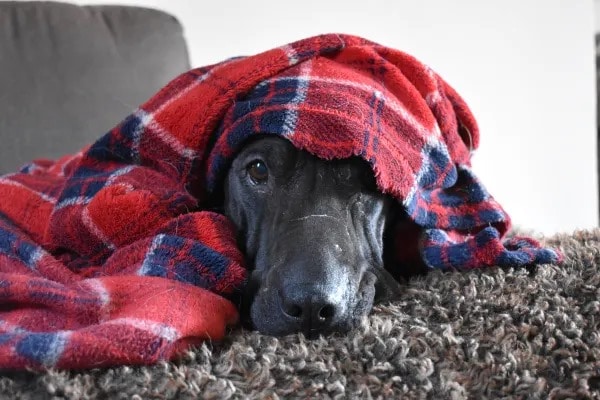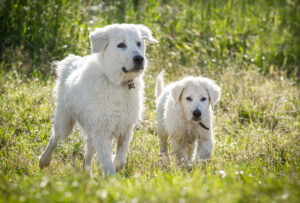The loud crash of thunderstorms can be pretty scary, even to the point where adults unconsciously shudder when a deafening bang in the sky rocks the window panes, lampshade, and every cutlery in the house. Regardless of this, humans generally remain unfazed when rainstorms occur. But what’s it about dogs that make them perpetually afraid of thunder?
There are several reasons why dogs are afraid of thunder, but the chief cause is the build-up of static electricity, which charges the air and delivers dogs with a mild shock during a thunderstorm. Alongside other reasons, this mild shock can make dogs uncomfortable and restless during a cloudburst.
In this article, you’ll learn all the reasons why dogs are afraid of thunder, how to stop a dog from being afraid of thunder and whether gabapentin can cure thunderstorm phobia.
Why Are Dogs Afraid Of Thunder?

Dogs are afraid of thunder mainly because their brains are wired like humans, fearful of strange feelings and sounds.
Puppies, just like babies, have an innate fear of noise. The difference between babies and puppies is that as babies grow to notice that other humans aren’t afraid and panicky when thunder booms, they unconsciously learn not to be frightened anymore.
But, in the case of puppies, this aversion to harsh noise mostly doesn’t go away except with deliberate, constant training.
Interestingly, about 30% of dogs have a big phobia of loud noise. Hence, this is quite a common phenomenon that shouldn’t make you frightened, especially if your four-legged companion is still a puppy.
Sadly, the reason why loud noise is a problem with dogs is that once your canine develops an aversion to it without the right conditioning, that unpleasant feeling will only intensify as the years go by and become increasingly difficult to correct in adulthood.
These fear could worsen to the point where other associated sounds during a thunderstorm like the howling of the wind and the pattering of the rain may become responsible.
That said, here are three main factors that make dogs scared during a cloudburst:
Tingling From Static Electricity
Have you ever noticed tiny little sparks on a woolly cloth during dry periods, especially when you stretch it in the dark? That’s static electricity. And it’s one of the reasons why your furry buddy acts tense anytime thunder crashes.
During thunderstorms, the rapid movement and agitation of the wind cause the collision of atomic particles, charging the air with static electricity. Naturally, since most dogs have furry coats that readily absorb static electricity, your pooch might get a mild shock on its body or when it rubs its nose against a metal object.
This unexpected shock, coupled with the mounting anxiety from thunderclaps and howling winds, cause dogs to become restless and scamper for safety when storm clouds rise again in the future.
Improper Conditioning
Although not the root cause of thunderstorm phobia, since all dogs possess an innate fear of loud noise, improper conditioning can act as an additional factor that worsens the fear of thunder in dogs.
As a dog parent, you could worsen your dog’s angst by conditioning it to become fearful whenever a thunderous noise occurs.
Conditioning occurs when a dog owner trains their canine to associate certain circumstances or actions with pain, like sharp cautions or pleasure such as treats and cuddles.
In order to understand how conditioning works, let’s quickly take a look at a famous dog-conditioning experiment that happened in the late ‘80s.
In 1897, Ivan Pavlov, a Russian physiologist, discovered that he could get dogs to drool and crave food by ringing a bell just before serving a delicious meal.
Over a particular length of time, Pavlov conditioned the dogs to associate the thought of a sumptuous meal and pleasure each time the bell rang.
This pattern became ingrained in the dogs’ brains that even when Pavlov didn’t serve the dogs food, a slight jingle of the bell was enough to get them excited and salivating.
This same conditioning is what happens when a dog parent races over to their whimpering and scared furry pal in a bid to provide calm and comfort during a thunderstorm. The act of running to your pooch’s side whenever there’s a loud noise is an unconscious way of saying that the booming of thunder is something dangerous that your dog needs protection from.
Do this repeatedly, and with time, you create an unhealthy dependency condition. And that’s because your dear Fido knows that the more it shivers and panics during a thunderstorm, the more comfort and pampering it’ll receive from you.
How Do I Stop My Dog From Being Afraid Of Thunder?

When a thunderstorm starts brewing and your four-legged companion starts to become anxious, there are several things you can do; if not, to stop the anxiety completely, at least reduce it to the barest minimum.
Some of the things you could do to help your canine are listed below:
Conditioning Your Dog The Right Way
The proper conditioning from puppyhood goes a long way in eradicating the fear of thunder in your dear Fido. You can do this by restraining yourself and resisting the urge to run to your doggie’s aid whenever thunderclaps happen.
Understandably, remaining put might be difficult for many dog parents, especially if you’ve been doing so in the past. And that’s because it’s an almost automatic, emotional response to comfort a whimpering dog.
However, it’s important to note that doing so is counterproductive and refusing to give in to your puppy’s frightful whimper is for the greater good.
Also, keep in mind that the slightest feeling of surprise or shock on your part is enough to send the wrong signal and make your doggie’s fear heightened. So try to keep calm and remain unbothered when your pooch begins to display signs of fear.
Another excellent way of reconditioning your dog to be at ease during a thunderstorm is by going out to play together minutes before the storm arrives. Doing so while being relaxed will give your dog the impression that darkening skies, storms, lightning, and thunder that follow aren’t something to be fearful of.
You can check your weather app to predict the estimated time the cloudburst will hit and then plan 30 minutes of playtime before the rains begin.
Again, another wonderful method that many dog owners have found helpful in conditioning dogs to remain calm during thunderstorms is desensitization through the use of special soundtracks.
Desensitization can be achieved by playing a soundtrack that delivers a real-life thunderclap effect. Starting with a low volume and gradually increasing as your doggie starts to get accustomed to the noise, you should be able to condition your dog to remain calm, and later on, eradicate the fear of loud noise altogether.

Provide A Safe Place For Your Dog
Sometimes, no matter how hard you try to condition your dog to be calm in the face of a rainstorm, some dogs won’t just sit still. In such cases, you can assist by providing a safe place where your furry pal can find comfort until the downpour subsides.
Interestingly, when dogs get a little shock due to static buildup, they generally scamper to a place where they feel safe. Some dogs are wont to hide behind the toilet seat, while others feel a little more comfortable inside the bathtub.
Whatever place they choose to hide, once you detect your dog’s ‘canine cave,’ you can help make it more comfortable by providing a blanket, a bed, or any other thing of succor.
Use Dryer Sheets
Dryer sheets help disrupt the buildup of static electricity in a dog’s fur. By giving your dog a good rub-down with an unscented sheet, you help to reduce the tingling to the minimum and prevent unnecessary anxiety.
Can I Use Gabapentin To Cure My Dog’s Thunderstorm Anxiety?
Yes, you can use gabapentin to address the fear of rainstorms in dogs, especially in cases where your canine becomes uncontrollable or hysterical.
However, the problem with gabapentin is that it only treats the symptom and not the cause of the hysteria.
In other words, using gabapentin doesn’t address the underlying issue that’s creating the thunderstorm phobia, ensuring that the same problem keeps on recurring with no lasting solution in sight.






